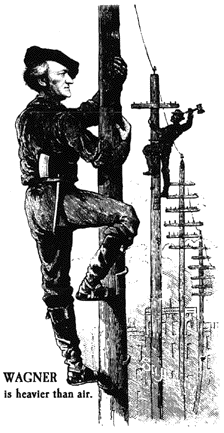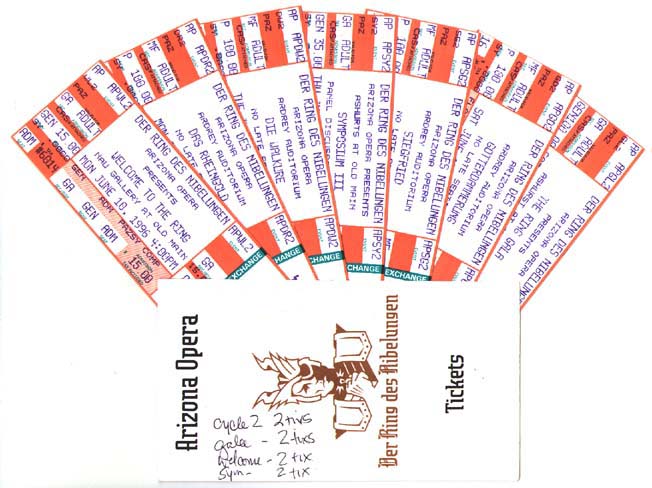Maestro Henry Holt on Wagner
(First published in Planet Magazine, 07jun1995)

If you think you haven't heard Wagner, you may have heard Wagner without knowing it. It's even possible that you liked it. Classic opera repertoire is often used as background music in commercials, films, and even cartoons. Bugs Bunny's "What's Opera, Doc?" for instance, is a pastiche of Wagner's music, and perhaps Wagner's best known piece of music, "The Ride of the Valkyries, " appears in Norwest Bank commercials and in Francis Ford Coppola's Apocalypse Now.
"We have to resign ourselves to the most obvious uses of any popular music—though I don't think it's a wonderful thing," says Henry Holt, Conductor of Arizona Opera. "There is an overuse of music generally, as a background tapestry for a cocktail party, or inciting people to shop a certain way. There is a sort of music suited for that. But I don't think it's the music of the masters—that really requires your full attention. There's a lot of opera being used in commercials and I think it's terrible."
Holt is not, however, the stereotypical snooty Wagnerian. He doesn't object to all popular uses of opera. Case in point: "There was one good scene dealing with opera,'' he says, "in a movie—Pretty Woman—where [Richard Gere's character] flies her up to San Francisco to see La Traviata and he says, 'Some people don't get it at all, some people get it and it's with them for life.' And she gets it. She doesn't really understand it moment for moment, but the whole thing has an immense impact on her—that is for her unforgettable. That was quite tastefully done, very well conceived."
Holt is sitting in the spacious and airy lobby of Northern Arizona University's Ardrey Auditorium, the locale of next year's staging of Wagner's cycle of operas, The Ring. The theatre's dimensions are comparable to Wagner's theatre at Bayreuth, a theatre specifically designed for the performance of Wagnerian opera.
NAU will spend $900,000 renovating Ardrey, including the removal of a load-bearing concrete wall behind the orchestra pit to make room for 70-plus musicians. Technical Director Brent Karlherg refers to Ardrey's current lighting board as "the museum piece," and indeed it is. The Century Strand company, maker of the board, has requested it for their museum because it is the last working model in the U.S.
David Whorton, Dean of the College of Creative Arts, says the University is spending most of the renovation dollars on modifications to bring the theatre up to Americans With Disabilities Act requirements. Specific modifications include a wheelchair ramp, elevator, and special rows of seating.
Like most Wagner devotees, Holt says "it's very easy to become so fascinated with Wagner that you don't want to do anything else." His own devotion dates from childhood, a devotion not shared by his family, who were European refugees from Hitler's Germany. "Since there was this love affair between Hitler and Wagner's music," he explains, "Wagner became somewhat disparaged by my family. They were all musicians and they knew this was great music, but they just wanted to push it over there, so I thought, as a kid, 'well, that must be really interesting stuff."'
The heavy mythological content of Wagner's operas appealed to the young Holt, whose grandfather was a wonderful storyteller. "He told me all the Norse legends and how Wagner brought them together, borrowing from this and that. The stories were fascinating. Gradually, as I became a musician and really started listening and trying to play, I became increasingly fascinated by Wagner."
His vision of staging The Ring developed, strangely enough, in Los Angeles. "I grew up, after escaping from Europe, in Los Angeles, and there wasn't any opera there. I didn't know that I'd ever see these operas, really, so they began to grow in my imagination. I said, 'All right, if I can't see them, I'll imagine them."'
Holt's approach to staging concentrates on theme and character development. By stepping down from the podium and into the audience, the conductor took note of elements in the presentation that didn't work and asked himself, "What am I annoyed with? Am I annoyed with the finger of the director pointing to something I might not find interesting? Am I being led through this like some kind of a half- wit?"
Rather than cluttering the stage or the opera with lots of scenic detail and hundreds of props, Holt attempts to let Wagner's themes speak for themselves: "the loss of love to the seeking of power and how that destroys relationships, how that destroys love, the descending spiral that is occasionally buoyed up by hope, though false hope." One major element in the Arizona production is the use of projections to suggest, literally and metaphorically, changes of place and mood, much like Wagner's own leitmotifs.
An indelible part of his compositions, leitmotifs are short musical phrases that recur with a given character, situation, or emotion. "What's great about The Ring is how specific it is. You can look at any bar of music and know what goes on in that moment." Wagner's use of the leitmotif revolutionized opera. Leitmotifs also indicated the level at which the composer pursued his art form: "The remarkable thing about Wagner is not that he was like Schubert or Mozart or someone who had talent from a young age. He had to work very hard for his concept. He was mad! And he made himself more mad because he had to create out of what was originally a modest talent—his own genius, he had to force it into being."
Leitmotifs were only one of Wagner's innovations, Holt explains. Though many dismiss his music as "bombastic," it has a depth not readily accessible at first hearing. "You listen to something like 'Forest Murmurs,' which is new music, a whole new sound, music that nobody had ever thought of before. You look into all the wonderful and delicate subtleties that really pay off Wagner has an unerring instinct of timing precisely the right sound, not just the right motive."
Holt says that Wagner's themes are so lucid, and at the same time so beautiful, that even children can identify and remember them. "I think when you get to the whole concept of truth, by which I mean those things that hit you and everything is right, the sound is right, the kind of music is right, the way in which it is being played or sung and what happens dramatically to create that is right. Then we have the great truth—and Wagner is loaded with that."
© Deuce of Clubs and Megan Halverson

|

